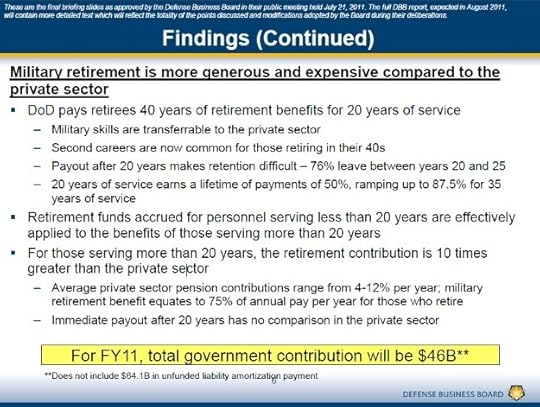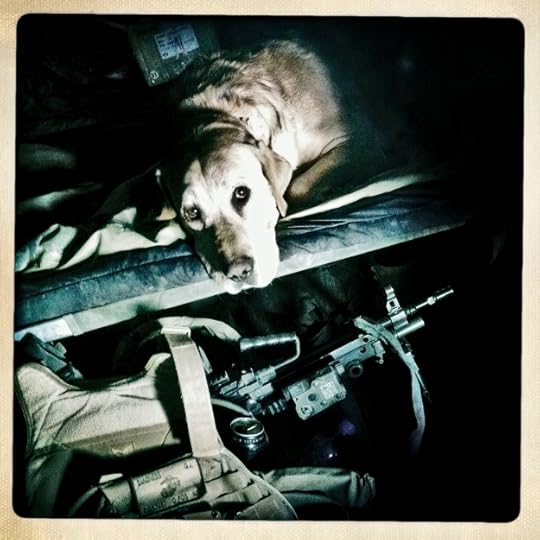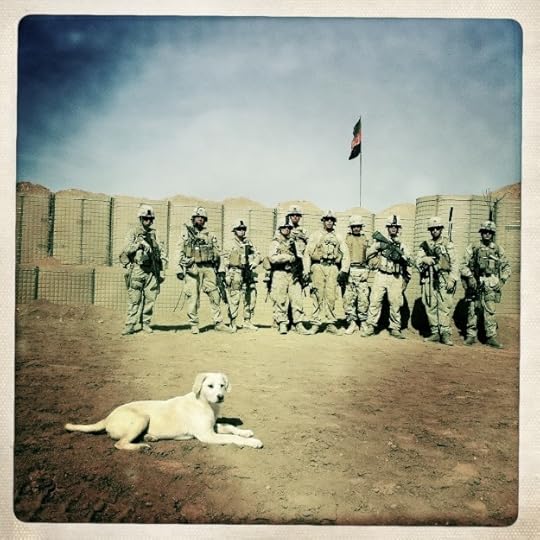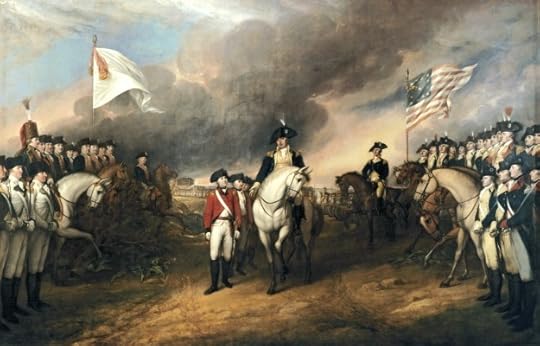Thomas E. Ricks's Blog, page 236
August 1, 2011
I'm outta here

I'm
planning on giving this blog a rest for the month of August. I plan to be back
up on Thursday, September
1.
Until
then, please feel free to use this item to post comments for discussion. Be
nice.
July 29, 2011
Is climate change the biggest national security challenge we are facing?

By Eric Hammel
Best Defense guest columnist
Over the past year, I've worked the vast security implications of global climate change into a few comments on The Best Defense, but they haven't taken hold. I cannot fathom the prevailing so-what attitude as the FEMA-grade weather disasters mount toward becoming serial and routine occurrences. It's here now, for all to see.
Tens -- perhaps hundreds -- of millions of heat, drought, flood, and famine refugees are probably going to be shaken loose within a decade. (Some estimates say half of humanity -- 3,000,000,000 people -- will have to move or die just from heat-related causes.) Thanks to topsoil erosion via drought and helped along by deadly, unstoppable tornado clusters and unlivable ambient temperatures, the bulk of farming in North America will shift northward and most likely will become restricted to a narrower band in the upper Midwest and on into higher Canadian latitudes-assuming there is sufficient rainfall there. Sea-level rise from melting glaciers on land will soon be poised to shake loose uncountable refugees from drowned coastal regions, where most of the world's people live. If the warm North Atlantic conveyor current is halted or recedes southward due to desalinization via the Greenland freshwater ice melt, the Canadian Maritimes, New England, and northwestern Europe will probably experience unbelievable winters and might (this is counterintuitive) freeze over.
Global famine is going to force the use of our military as a police force organized to feed unknowable masses of people (until cold reality sets in as reserve food stocks evaporate). I believe that North America's first up-close brush with famine-motivated mass migration will take place in northern Mexico and on into the U.S. border states. (Refugees fleeing in the wake of the collapse of Mexico's central government could precede drought- and heat-related dislocations. Are we prepared to handle such a dress rehearsal?)
The only force on Earth with the inherent capability to police, process, house, feed, and move refugees on a mass scale is the U.S. military, but, though its reach is global, its capacity and stamina are nonetheless limited, probably to one or two major disasters at a time, not the overlapping rolling meta-disaster climatologists predict. (Remember, the only components of the Katrina effort that worked at all were the military responses, beginning with Coast Guard helicopters.)
The implications for military use alone in the looming weather-related crises are mind-boggling, but no one appears to want to face up to them with an action plan, a doctrine, a list of precepts. I find it worrying to the nth degree that there is absolutely no public discussion. Have the relevant agencies studied it all already-and thrown up their hands? I already know from a series of phone calls to relevant local and state agencies that there is no actual integrated plan in place to respond to high-impact earthquakes in major California population centers. The "plan" is to play it as it lays. And I sincerely doubt that a repeat of Katrina would be met with an effective plan based on lessons learned.
Can we bring this out of the shadows, and least in this venue?
Eric Hammel has written more books about the U.S. military in Vietnam, Korea and World War II than most people have read.
Defense budget implosion (VII): Kiss those retirement bennies goodbye?

Check out this Pentagon briefing on how military retirees are overpaid and overbenefitted. Now do you believe me?
Says an Army friend, "I think any changes made to the military retirement system should be made, measure for measure, to the House and Senate retirement plans. It might be a symbolic gesture, but it would probably be enough to keep me from breaking out the torch and pitchfork." I like that idea.
A history of Israeli counterterrorism offers some CT lessons for Washington

By Matthew Irvine
Best Defense directorate of Delta force activities
After a decade of counterterrorism, the United States still doesn't quite seem to have the right formula. As we look back on a decade of lessons learned, it is useful to also study what our allies and partners have been up to in their own fights with terrorism.
Daniel Byman's new book, A High Price: The Triumphs and Failures of Israeli Counterterrorism, tells the story of Israel's seven decades of counterterrorism. Byman overcomes the potential minefield subject of Israel/Palestine by tracing the arc of contemporary Israeli policies and challenges to their historical roots, often dating back to the British Mandate period and the 1967 war.
What struck me when reading Byman's book?
The Israeli military and politics are truly familial. Many of Israel's political and security officials today have worked together for decades, starting as soldiers in the IDF. Benjamin Netanyahu and Ehud Barak served on the same commando team that freed a hijacked El Al plane in 1972. Somberly, Bibi's brother Yonatan Netanyahu was killed in the famous Entebbe raid in 1976. These intimate relationships and the country's close ties to its military forces make the use of force, especially commandos, a very personal affair for those in power.
The long learning curve of countering terrorism. Israeli intelligence was forced to adapt as Black September emerged in the 1970s, as the PLO built a mini-state in Lebanon, the Palestinian Authority took power after Oslo and amidst the Second Intifada and the rise of Hamas. These required a relatively small cadre of counterterror specialists to constantly look for new openings in collection, new avenues of disruption and better ways to harden defenses. Israel still hasn't perfected its methods to say the least but has established an impressive record to versatility in a persistent irregular conflict. The United States should take note as we enter a second decade of war: retaining top level talent and constantly learning is key to long-term success.
The dangers of sanctuary. According to Byman, "Israel's history shows that no factor is more important to the success of a terrorist group than sanctuary." This argument is supported by studies of insurgencies in Afghanistan and Pakistan as well. Israel has focused much of its historical efforts on eliminating these sanctuaries both within and outside its borders. However it is important to note that as one safe haven closed, inevitably another appeared, whether in Jordan, Syria, Lebanon, Algeria or Gaza.[[BREAK]]
Counterterrorism cannot be removed from counterinsurgency. As the debate over the Biden CT+ option in Afghanistan continues in DC, the Israel example highlights the need for wider strategies than simply killing bad guys. Byman wisely notes that "most of the groups Israel has faced, particularly the most dangerous ones, are involved in much more than terrorism…. When thinking beyond terrorism and in terms of political policy, the Israeli government should draw lessons from counterinsurgency, which addresses not only the military dimensions but also the political, economic, and social ones as well."
The threat of domestic terrorism looms large. Jewish terrorism is nothing new in Israel. Leaders such as Menachem Begin led pre-independence terrorist groups such as Irgun and the Stern Gang. This thread continues today with the fringes of contemporary settlers. As great as the threat from outside seems, problems at home always demand attention.
The book chooses breadth over depth in its attempt to cover seven decades of conflict and evolution and may leave those with their own libraries on Israel/Palestine wanting for more. Nonetheless, A High Price is a great introduction to Israeli counterterrorism.
Matthew Irvine is a research assistant at the Center for a New American Security, where he works on the Terrorism, Irregular Warfare and Crime Project. He is a co-author of "Beyond Afghanistan: A Regional Security Strategy for South and Central Asia."
Rebecca's War Dogs of the Week: Hipstamatic canines from the 1/8

By Rebecca Frankel
Chief Canine Correspondent
This week, FP is running a 5-part photo series: The War in Hipstamatic. A mesmerizing collection, these images were shot with iPhones by a group of photojournalists who embedded with the Marines in Battalion 1/8 in Helmand province for five months starting in September 2010. (It's all part of a project called Basetrack -- I encourage Best Defense readers to check it out.)
The photos from this foray into app-image journalism number in the thousands and I was happy to discover among them three portraits of the company's dogs -- two bomb-sniffers and one adopted stray.
Above: Gunner,
a military working dog, looks up from the cot where he was resting at Patrol
Base Dehanna, in Nawzad district, on Jan. 9.
Image by Teru Kuwayama
[[BREAK]]

Layla the Dog: TBJ Marines on foot patrol found Layla when she was a puppy, but because of IED risk, taking her on patrols was too dangerous and they decided to trade her for some cigars to Cpl. Brady "Pancho" Cervantes, 23, of 1/8 3rd Platoon, from Dallas, Texas. Here she is with her Marines from the 1/8 at Shir Ghazay Patrol Base in Landay Nawah County, Afghanistan.
Image By Rita Leistner

Cpl. Gretchn at Combat Outpost 7171: Gretchn is IED Detector Dog with 1st Battalion 8th Marines Bravo Company, First Platoon. Here she poses -- just as the rest of her Battalion did -- in Helmand Province, Afghanistan on Oct. 30, 2010.
Image by Balazs Gardi
Repealing a gay ban: No, in fact the world did not end when it was lifted

By Nora Bensahel
Best Defense guest columnist
Some 70 percent of serving military personnel said that allowing gays to serve openly would damage combat effectiveness. A full 74 percent said that it would be difficult to maintain discipline. And 66 percent said it would damage recruiting.
Every single one of them was wrong.
Even though President Obama has now certified that the military is ready to repeal the "don't ask, don't tell" policy, many people remain worried that this policy change will harm the military. Yet the experience of the British military -- our closest ally and fighting partner -- should put those fears to rest.
The numbers above come from a 1996 survey of British military personnel conducted by the Ministry of Defence (MOD) about whether gays should be allowed to serve openly. The vast majority opposed the change and predicted dire consequences. In 2000, a European court decision forced the MOD to allow gays to serve openly. Soon after the policy change, something remarkable happened.
Nothing.
Combat effectiveness remained high -- as proven in Afghanistan, where British soldiers have been fighting and dying alongside their American counterparts. Discipline, recruiting, and retention did not change at all. Many British personnel who served at the time recall that "the world did not end" -- military life continued as usual. Six months after the policy change, an MOD review found that there was "widespread acceptance of the new policy" and a "marked lack of reaction." Another review two years later not only confirmed the earlier findings, but concluded that "[n]o further formal review of the Armed Forces policy on homosexuality is currently judged to be necessary." Ten years later, many of those who served at the time have acknowledged that they were wrong.
The United States and the United Kingdom are different, of course. All military personnel reflect the societies that they serve, so the domestic context matters greatly. Yet two important aspects of the U.S. domestic context suggest that implementing a policy that allows gays to serve openly will proceed just as easily as it did in the United Kingdom.[[BREAK]]
First, the U.S. is changing its policy through the legislative branch of government, not the judicial branch. Congress voted last year to change the law through the normal democratic process, the same way that it changes laws on education, the environment, health care, and so on. Individuals may strongly disagree with those changes, but few question the legitimacy of the process itself. That makes it much more likely that U.S. military personnel and the American people broadly will support the policy change than if it were forced through a court decision, as happened in Britain.
Second, U.S. military personnel are far more ready to accept this policy change than British military personnel were. Last year, the Department of Defense surveyed the force and found that 69 percent believe that they have already served with someone who is gay. Large majorities believed that unit readiness and recruiting would either remain unchanged or would improve, and only 13 percent believed they would leave military service sooner than they planned.
Views among ground combat personnel were consistently less positive, but even there, 52 percent of Army soldiers and 42 percent of Marines believed that the ability of their unit members to work together would improve or remain unchanged. However, people generally do a very poor job of predicting their own future behavior. Much larger majorities of British military personnel predicted that allowing gays to serve openly would have terrible consequences, yet none of them occurred. Additionally, all U.S. military personnel have received specific training on this policy change during the past six months, which may have addressed some of their concerns.
Last summer, I spoke with a young British soldier who openly identifies himself as gay and had just returned from several months in Afghanistan. He joined the British equivalent of the Junior ROTC before he was a teenager, enlisted at 18, and had just been selected to serve as a commissioned officer. He knew that there was a lot of opposition to letting gays serve in the military 11 years ago, but wonders what all the fuss was about.
Someday soon, American soldiers, sailors, airmen, and Marines will wonder the same thing.
Nora Bensahel is the Deputy Director of Studies and a Senior Fellow at the Center for a New American Security, the Little Think Tank That Could.
Hey, who borrowed my name and occupation and moved me to France?

Apparently there is a new movie about me -- see plot summary below. I wouldn't mind except I didn't even get to meet Kristin Scott Thomas. I thought she was terrific in The English Patient, which by the way I think is one of the best movies I've seen on the effects of combat on people. Also, I've never worked as a night guard. But I have had my life taken over by "an obscure power" -- that's one way of looking at the Iraq war.
Also, as I've said, my self-image runs more to Homer Simpson than to Ethan Hawke.
Woman in the Fifth (Pawel Pawlikowski)
American writer Tom Ricks comes to Paris desperate to put his life together again and win back the love of his estranged wife and daughter. When things don't go according to plan, he ends up in a shady hotel in the suburbs, having to work as a night guard to make ends meet. Then Margit, a beautiful, mysterious stranger walks into his life and things start looking up. Their passionate and intense relationship triggers a string of inexplicable events … as if an obscure power is taking control of his life. Stars Ethan Hawke and Kristin Scott Thomas.
July 28, 2011
Emma Sky and the deserted Roman ruins: Being the last tourist in Syria

By Emma Sky
Best Defense roving Middle East correspondent
Is this your first visit to Syria, the passport-control man asks me. No, I tell him, I came here once before over a decade ago. He stamps my passport. I had been very lucky to get a Syrian visa this time. The travel advice was not to visit. The Syrian regime is very wary of foreigners, fearing that journalists and spies are inflaming the situation further. I collect my bag and walk through customs, passing a poster, of modest size, of President Bashar al-Assad with the words in Arabic proclaiming: "Leader of the youth, hope of the youth."
I jump in a taxi. I ask the driver how are things in Syria. Things are fine, he assures me. There has been some trouble around the country, but things are OK in Damascus. As we drive, we chat. He points out the area where Druze live. With his hand, he waves in another direction to where Palestinian refugees live, and then again to where Iraqi refugees live. Alawites are over there and in villages. Christians this way and in villages. Sunnis are around 65 percent of the population. Kurds live in the north. Many different peoples live in Syria. I ask him how he knows who someone is or whether they are Sunni or Shiite. He tells me that he does not know and it does not interest him to know: There is no sectarianism here in Syria. We pass Damascus University. Outside there are lots of flags and pictures of Assad and his deceased father. Across the city, the Syrian flag is flying strong and photos of the president are omnipresent. As I ride through al-Umawiyeen Square, I see lots of young men and women gathering, holding Syrian flags. It is not a demonstration, a Syrian tells me; it is a celebration -- a celebration of the regime. Later, I watch the event on television. It has made the international news. Tens of thousands of Syrians have come out to al-Umawiyeen Square to show their support for President Bashar al-Assad in a lively celebration that includes pop singers and fireworks.
When I had visited previously, the city had been filled with huge pictures of Hafez al-Assad; and Bashar, his son, had been studying ophthalmology in London. The death of Bashar's elder brother, Basil, in a car crash, propelled him back into the family business of ruling Syria.
In the evening, I stroll down the street to a restaurant. It is very modern and Western. All-you-can-eat sushi for $20. I try to read my emails on my BlackBerry. I switch between two different networks, but can only receive GPS, not GPRS. The restaurant claims to have Wi-Fi. I ask the waiter. There is Wi-Fi, he tells me, but it is not working at the moment. Nor is Facebook. Internet access is limited.
I walk through Souq al-Hamidiyah in the old city of Damascus. It is a wide, pedestrianized street, two-stories high, and covered. It is buzzing with life. Store owners sit outside their shops, trying to entice potential customers. Traders sell their wares down the middle of the street. Walking with the flow of people, I emerge to find the Umayyad Mosque directly in front of me.
I go to the ticket office, pay the entrance fee for foreigners, and collect a hooded gray cloak to cover myself. The cloaks come in three sizes. A woman sitting there directs me toward the smallest size. The cloak stinks, and I wonder when it was last washed and how many women have had to wear it in the sweltering summer heat. I put the cloak on over my clothes, pulling up the pointed hood to ensure my hair is covered. I enter the Umayyad Mosque -- built on the site of a shrine dedicated to John the Baptist -- looking like a member of the Ku Klux Klan except dressed in gray, and carrying my shoes in my hand. I wander into the covered area where hundreds of people are praying, men in one area, women in another. I walk out to the courtyard. In one area, a group is seated on the ground. One man is kneeling, raising his arms, weeping "ya Hussein." The others follow suit, tears flowing, looking quite distraught.
The rest of this article can be read in its entirety: here.
What's the hurry? The lieutenant colonels of 9/11 begin to pin on 2 stars

I was looking at the Army's list of brigadier generals nominated for two stars, released yesterday, and was struck by how many of them I knew as battalion commanders during the first days of the response to 9/11. I am glad to see this happening. But it does seem to me that a decade is an awful long time for battalion commanders to move to division commander during wartime. Maybe it is a good thing, but it certainly is a departure from big wars of our past that I've been studying.
This looks like the next bounce for the BGs picked by the board led by General Petraeus a couple of years ago. Which makes it all the more puzzling to see a big hole in this list. As two friends, and several commenters on the Dempsey item yesterday, pointed out: Where is "probably-our-best" Brig. Gen. H.R. McMaster on this list? What up with that?
Here's the list:
Army Brig. Gen. Ralph O. Baker has been nominated for appointment to the rank of major general. Baker is currently serving as director for operational plans and joint force development, J-7, The Joint Staff, Washington, D.C.
Army Brig. Gen. Allen W. Batschelet has been nominated for appointment to the rank of major general. Batschelet is currently serving as deputy chief of staff, G-3, U.S. Army Europe and Seventh Army, Germany.
Army Brig. Gen. Heidi V. Brown has been nominated for appointment to the rank of major general. Brown is currently serving as director of integration, Office of the Deputy Chief of Staff, G-8, U.S. Army, Washington, D.C.
[[BREAK]]
Army Brig. Gen. John A. Davis has been nominated for appointment to the rank of major general. Davis is currently serving as director, current operations, J-33, U.S. Cyber Command, Fort Meade, Md.
Army Brig. Gen. Patrick J. Donahue II has been nominated for appointment to the rank of major general. Donahue is currently serving as director, concept development and learning, Army Capabilities Integration Center, U.S. Army Training and Doctrine Command, Fort Monroe, Va.
Army Brig. Gen. Robert S. Ferrell has been nominated for appointment to the rank of major general. Ferrell is currently serving as director for command, control, communications and computer systems, U.S. Africa Command, Germany.
Army Brig. Gen. Stephen G. Fogarty has been nominated for appointment to the rank of major general. Fogarty is currently serving as deputy chief of staff, intelligence, International Security Assistance Force, Operation Enduring Freedom, Afghanistan.
Army Brig. Gen. Charles W. Hooper has been nominated for appointment to the rank of major general. Hooper most recently served as deputy director for strategic planning and policy, J-5, U.S. Pacific Command, Camp H.M. Smith, Hawaii.
Army Brig. Gen. Paul J. LaCamera has been nominated for appointment to the rank of major general. LaCamera is currently serving as deputy commanding general (operations), 25th Infantry Division, U.S. Division-Center, Operation New Dawn, Iraq.
Army Brig. Gen. Sean B. MacFarland has been nominated for appointment to the rank of major general. MacFarland is currently serving as deputy commandant, U.S. Army Command and General Staff College, Fort Leavenworth, Kan.
Army Brig. Gen. Kevin W. Mangum has been nominated for appointment to the rank of major general. Mangum is currently serving as commanding general, U.S. Army Special Operations Aviation Command, Fort Bragg, N.C.
Army Brig. Gen. Roger F. Mathews has been nominated for appointment to the rank of major general. Mathews is currently serving as deputy commanding general, U.S. Army Pacific, Fort Shafter, Hawaii.
Army Brig. Gen. Austin S. Miller has been nominated for appointment to the rank of major general. Miller most recently served as commander, Combined Forces Special Operations Component Command - Afghanistan, Operation Enduring Freedom, Afghanistan.
Army Brig. Gen. Camille M. Nichols has been nominated for appointment to the rank of major general. Nichols is currently serving as program executive officer, soldier, Fort Belvoir, Va.
Army Brig. Gen. John R. O'Connor has been nominated for appointment to the rank of major general. O'Connor is currently serving as deputy chief of staff, G-4, U.S. Army Forces Command, Fort Bragg, N.C.
Army Brig. Gen. Gustave F. Perna has been nominated for appointment to the rank of major general. Perna is currently serving as commanding general, joint munitions lethality, Life Cycle Management Command/Joint Munitions Command, Rock Island, Ill.
Army Brig. Gen. Warren E. Phipps Jr. has been nominated for appointment to the rank of major general. Phipps is currently serving as deputy director for regional operations, J-3, The Joint Staff, Washington, D.C.
Army Brig. Gen. Gregg C. Potter has been nominated for appointment to the rank of major general. Potter is currently serving as commanding general/commandant, U.S. Army Intelligence Center of Excellence and Fort Huachuca, Fort Huachuca, Ariz.
Army Brig. Gen. N. Lee S. Price has been nominated for appointment to the rank of major general. Price is currently serving as program executive officer, command, control, and communications (tactical), Aberdeen Proving Ground, Md.
Army Brig. Gen. Edward M. Reeder Jr. has been nominated for appointment to the rank of major general. Reeder is currently serving as commanding general, U.S. Army Special Forces Command (Airborne), Fort Bragg, N.C.
Army Brig. Gen. Jefforey A. Smith has been nominated for appointment to the rank of major general. Smith is currently serving as assistant commanding general for police development, North Atlantic Treaty Organization Training Mission - Afghanistan/Combined Security Transition Command - Afghanistan, Operation Enduring Freedom, Afghanistan.
Army Brig. Gen. Jeffrey J. Snow has been nominated for appointment to the rank of major general. Snow is currently serving as director, J-5, U.S. Forces-Iraq, Operation New Dawn, Iraq.
Army Brig. Gen. Kenneth E. Tovo has been nominated for appointment to the rank of major general. Tovo most recently served as deputy commanding general (support), 1st Armored Division, Germany.
Army Brig. Gen. Stephen J. Townsend has been nominated for appointment to the rank of major general. Townsend is currently serving as director, Pakistan/Afghanistan Coordination Cell, The Joint Staff, Washington, D.C.
Army Brig. Gen. Thomas S. Vandal has been nominated for appointment to the rank of major general. Vandal is currently serving as commandant, U.S. Army Field Artillery School, U.S. Army Fires Center of Excellence, Fort Sill, Okla.
Army Brig. Gen. Mark W. Yenter has been nominated for appointment to the rank of major general. Yenter is currently serving as director, Joint Engineering Directorate, U.S. Forces-Afghanistan, Operation Enduring Freedom, Afghanistan.
U.S. and al Qaeda agree on Syria

Proven provider John McCreary observes that the U.S. government and al Qaeda apparently are on the same side in calling for change in Syria:
Syria-al Qaida: Al-Qaida's new leader Ayman al-Zawahiri praised anti-regime protestors in Syria in a video released Wednesday claiming the United States is seeking regime change in Damascus, U.S.-based monitors said. Calling the pro-democracy activists 'mujahideen,' or holy warriors, Zawahiri hailed their efforts in "teaching lessons to the aggressor, the oppressor, the traitor, the disloyal, and standing up against his oppression" in a video the SITE Intelligence Group said was posted on extremist online forums.
Comment: For perhaps the only time on record, The US and al Qaida apparently are supporting the same policy end state for Syria: regime change. That bizarre coincidence cannot be good for Israeli security or regional stability.
Zawahari sees the conflict as a Sunni fundamentalist vs. Alawite struggle, not as a movement for plural political rights, women's rights and liberal freedoms against a repressive regime."
Thomas E. Ricks's Blog
- Thomas E. Ricks's profile
- 436 followers



